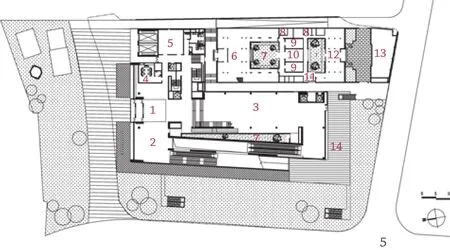南京城墙博物馆改扩建工程,南京,中国
2018-05-25倪阳
“迹”是一种活动模式或内在逻辑的外化。南京城墙博物馆在设计之初以“迹”作为出发点,试图建立起博物馆与参观者在活动模式上的关联,以及与场所在逻辑上的契合。
南京城墙博物馆位于南京中华门西侧的南京历史文化风貌展示区,它南望大报恩寺塔,北接内秦淮码头。方案寻“迹”主要从两个方面展开,一方面是如何设计使用者的参观线路,另一方面是如何建立与中华门的对应关系。在分析了展览活动的内容之后,方案试图将户外的实景展纳入参观线路之中,形成由内到外、由文献到实景的互动参观模式。沿着这条线索,再结合场地对尺度的特殊要求,将主要展览部分置入地下,而将临时展厅设在地面之上;并在屋顶设计了3个平台,供参观者观望中华门城墙、秦淮实景和门外的大报恩寺塔,巧妙地将建筑植入整体场地的景观中。进而借用中华门的马道形式,将3个平台联系、构形,在分解体量的同时,也与中华门城墙建立起一种关联,使建筑形式有“迹”可循。立面材质的选择基于两点:尊重,求新。方案采用了一种具有漫反射的玻璃作为立面外表皮,将建筑物周边的场景,特别是古城墙映射其中,产生出一种微妙的时间对比,让建立在此地的博物馆成为场景的一部分。坡道和观景平台铺地则沿用了古城墙的铺砌方式,适度引入了古城墙上“草”的印迹,将绿色从场地向屋顶逐级延伸,也为市民和参观者在闭馆期提供了一处在不同高度和角度观赏老城区景观的活动平台。
在一个历史文化内涵相对丰富的地方,如何通过设计对场地谨慎而又微妙地介入,创造出新的体验模式和建筑景观,是对特定场所进行营造的一种尝试。□

1 室内透视/Interior perspective

2 坡道透视/Ramp perspective

3 西南侧透视/Southwest perspective

6 二层平面/1st floor plan

4 地下一层平面/Floor B1 plan

5 首层平面/Ground fl oor plan

7 剖面/Section
"Trace" is the externalization of active mode or internal logic. At the beginning of the design of Nanjing City Wall Museum, we took "trace" as the starting point, and tried to establish the relevance between museum and visitors' activity mode, as well as the logical agreement between museum and site.
Nanjing City Wall Museum is located in the Nanjing historical and cultural feature exhibition area on the west side of the Zhonghua Gate in Nanjing, on its south side there is the Porcelain Tower, and the north side is the Inner Qinhuai dock. The search for "trace" was mainly from two aspects, on the one hand, it was how to design the visitors' tour route; on the other hand, it was how to establish the corresponding relationship with the Zhonghua Gate. After analysing the contents of exhibition, the programme tried to bring outdoor real landscape exhibition into the tour route, formed an interactive tour mode from inside to outside and from document to real landscape. Following this clue, combining with the special requirements of the scale of the site, the main part of the exhibition hall has been set under the ground. On the contrary, the temporary exhibition hall has been arranged on the ground. Meanwhile, we designed three platforms on the roof for visitors to enjoy the sight of the Zhonghua Gate and the Qinhuai Creek, as well as the Porcelain Tower outside the wall, ingeniously implanted the building in the overall site-landscape.Then we imitated the form of ramp of the Zhonghua Gate, and connected three platforms together, while weakening the volume, it established a connection with the Zhonghua Gate, made the architectural form to follow the "trace" logically. The choice of facade material was based on two points: respect and innovation. The project employed a kind of diffuse reflection glass as the outer skin of the facade and it could re fl ect the scene around the site,especially the ancient city wall, thus generating a subtle contrast of times and making the museum become a part of the scene. The ramp and landscape platform followed the paving method of ancient city wall. And the imprint of the grass on the city wall was appropriately adopted in the design and it extended the green from the site to the roof stepby-step, providing the citizens and visitors with a platform to enjoy the sight of the landscape of the old city from different heights and viewpoints.
In a place with rich historical and cultural connotation, how to get involved in the place prudently and subtly, as well as create a new experience model and a new architecture landscape is an attempt in constructing a speci fi c place.□
项目信息/Credits and Data
业主/Client: 南京城墙保护管理中心/Nanjing City Wall Protection Management Centre
设计团队/Design Team: 何镜堂,倪阳,何炽立,何小欣,吴中平,刘涛,杨浩腾,马辰龙,郑惠婷,苏皓,陈志东,徐好好,谢燮,黄莹,谢敏奇,陈志彪,张丽斯,韩谨如,陈鹏,原玮,吴鸣,方舟/HE Jingtang, NI Yang, HE Zhili, HE Xiaoxin, WU Zhongping, LIU Tao, YANG Haoteng, MA Chenlong, ZHENG Huiting, SU Hao, CHEN Zhidong, XU Haohao, XIE Xie, HUANG Ying, XIE Minqi,CHEN Zhibiao, ZHANG Lisi, HAN Jinru, CHEN Peng, YUAN Wei, WU Ming, FANG Zhou
建筑面积/Floor Area: 12,000m²
设计时间/Design: 2016.10 -2017.01
计划建成时间/Planned Completion: 2019
